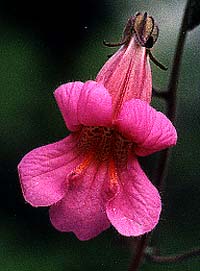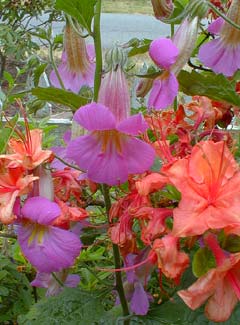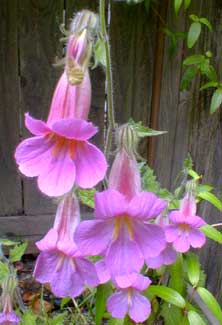
Chinese Foxglove,
aka Beverly Bells
"I gave thee immortal flowers,
That bloomed serene in heavenly bowers."
-Ella Maria Dietz Glynes Clymer,
b.1859
b.1859
Chinese Foxglove (Rehmannia elata, formerly R. angulata) has a genus name after the Russian physician Joseph Rehmann (1799-1831). This hardy perennial has large bright pink & red bell-flowers with yellow-spotted throats, which last well in bouquets.
The bells are arranged very much like common foxglove (Digitalis purpurea) but even more gorgeous, though the flower spikes are usually shorter. The spikes are sometimes only three feet tall, though our oldest specimens have shot up flower stalks that are over five feet tall.
It's not as prone as common foxglove to its flower spikes tipping over, but the tallest spikes do lean, not unpleasantly.
 It blooms as early as late spring & in climates that don't stress it with too much warmth. It is at its height June & July, continuing to blooming until first frosts of autumn, or later. Ours has bloomed as late as December, though certainly not full big exciting blooms like in summer & early autumn; rather, stunted flowers occur unexpectedly in the basal leaves without the usual stalks.
It blooms as early as late spring & in climates that don't stress it with too much warmth. It is at its height June & July, continuing to blooming until first frosts of autumn, or later. Ours has bloomed as late as December, though certainly not full big exciting blooms like in summer & early autumn; rather, stunted flowers occur unexpectedly in the basal leaves without the usual stalks.In zones farther south it will be unhappy in summer but bloom in winter.
In its preferred temperate zones it wants full sun & rich moist very well draining soil, becoming drought tolerant once it's been established for a year or two. It needs protecting from desiccating winter winds, & in colder zones an autumn topcoating of organic matter such as leafmold will lend further protection, though in temperate Zone 8 mulching is not necessary. In early spring it can be given a slow-release fertilizer, but demands little else.
Its furry foliage, quite short under the tall spikes of flowers, forms mottled bronzy rosettes. These will in a suprisingly short time form a sun-loving groundcover, each plant spreading & colonizing the area with startling rapidity. Smaller rosettes of leaves pop up from underground rizomes all around parent plants. On Puget Sound the basal leaves are fully evergreen, lending their beauty even to the winter garden, with or without its occasional & unpredictable winter bloom.
 The first photo was snapped July 2002. The second photo from June 2003 shows a spike reach up & through flowered limbs of a Rhododendron occidentale x calendulaceum or "Western Flame" azalea. The perennial foxglove had spread so aggressively by sending out so many stolens between the Western Flame & another deciduous azalea, R. x prinophyllum "Apricot Surprise" that by 2003 the numerous swiftly maturing youngsters actually began to choke out the light from the lower limbs of the azaleas, besides threatening to crowding out less aggressive perennials. So in Autumn I dug up all of the foxgloves, young & mature alike, & moved them together to a more open area where they have more room to dominate in their own right. I cut off all the leafed & flowered stalks before the move to the foot of a kiwi vine.
The first photo was snapped July 2002. The second photo from June 2003 shows a spike reach up & through flowered limbs of a Rhododendron occidentale x calendulaceum or "Western Flame" azalea. The perennial foxglove had spread so aggressively by sending out so many stolens between the Western Flame & another deciduous azalea, R. x prinophyllum "Apricot Surprise" that by 2003 the numerous swiftly maturing youngsters actually began to choke out the light from the lower limbs of the azaleas, besides threatening to crowding out less aggressive perennials. So in Autumn I dug up all of the foxgloves, young & mature alike, & moved them together to a more open area where they have more room to dominate in their own right. I cut off all the leafed & flowered stalks before the move to the foot of a kiwi vine.After the initial shock of transplant that caused the basal leaves to get wilty, they soon bounced back & even produced a few of those stunted winter blooms in their new location. The dense patch of Chinese foxgloves being now under a birdfeeder, the very competitive perennial has been pretty good at keeping spilled birdseed from sprouting. The third photo shows some blooms in this new location, at June's end, 2004.
Several plants of this genus including R. elata & especially R. glutinosa are used in Chinese & Japanese herbal medicines called shu di huang or sheng di huang or in Japanese Kampo medicine,Hachimi-jio-gan. When similar herbal preparations are offered in the west they tend to go under the genus name Rehmannia; "Rehmannia-8" for instance is a Kampo blend of eight herbs.
The Chinese tradition alleges that Rehmannia extends life or cures kidney ailments, which it has never seriously been proven to do. However, in combination with other herbs, Rehemannia might be beneficial in the treatment of eczema. One eight-week trial published in the Lancet in 1992 tested a mixture of ten herbs including Rehmannia, indicating benefit for eczema symptoms, although when the study was repeated, & published that same year in the British Journal of Dermatology, no value beyond that of a placebo was statistically perceivable, so the evidence is uncertain.
A twelve-week trial with findings published in the Annals of Allergy Asthma Immunology in 2002 found slight indications that a similar blend of herbs marketed as Bimmine gave some relief to allergic rhinitis. Studies on rats & mice conducted in Asia give rosier perspectives on "life extending" Rehmannia herbal blends. For example, a study of a Japanese Kampo blend dominated by Rehemannia increased elderly rats' running-wheel usage & stamina, without the harmful side-effects of, say, benzedrine or caffeine, a proven benifit for increased quality of life for elderly rats.
Several other animal studies, even if not often definitive, do leave sound reason to believe Rehmannia herbal blends have some, if usually slight, medicinal values in treating problems associated with old age. It may assist digestive activity; has an antioxidant effect; reduces bone calcium loss in elderly female rats with their ovaries removed (hence possibly a similar benefit in human old age); having also an anti-adrogenetic effect that reduced prostrate disease in sterilized male rats (hence not impossibly a similar value for sterilized old men); & reduces side-effects of radiation exposure in rats pre-fed Rehmannia herbal blends.
Such findings are invariably exaggerated to absurd degrees when paraphrased by vendors of herbal remedies, with a few additional values thrown in for good measure with no sound basis at all. Still, if one goes to the studies themselves, & overlooks the wild claims of vendors & herbal quacks, one does find indications of real medicinal value for Rehmannia blends, which alas cannot be said of the majority of herbs offered in the commercial arena.